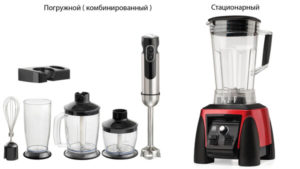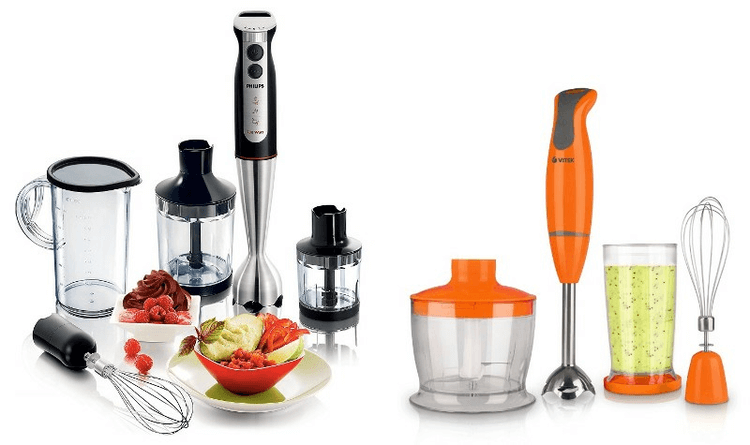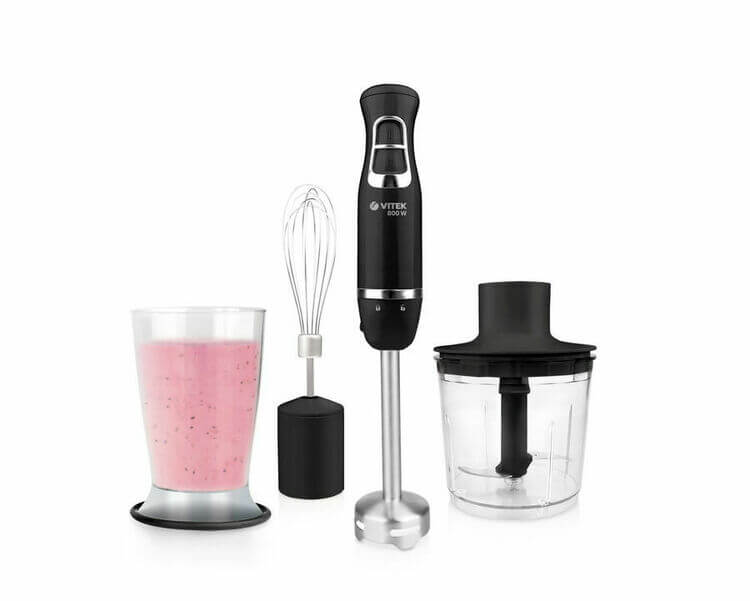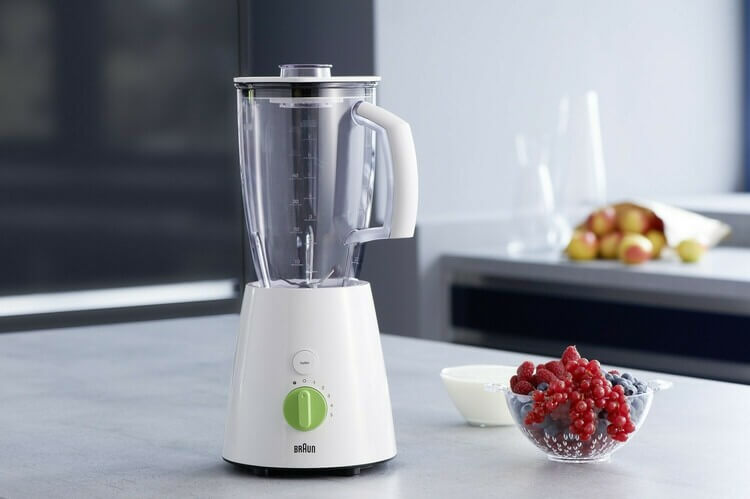Submersible or stationary blender: which is better and what to look for when choosing + customer reviews
 A huge number of its varieties are invented for homework.
A huge number of its varieties are invented for homework.
And to facilitate the work in the kitchen, speed up the process and the appearance of the possibility of preparing a variety of dishes, many kitchen appliances have been invented.
One of such devices is a blender.
Content
What is and what is the device like?
A blender is a household kitchen appliance that allows you to quickly grind food, chop ice, make mashed potatoes or sauce, beat a drink or mousse. The blender is stationary and submersible.
A stationary blender is placed on the table, it works quite autonomously, requires minimal control, submersible - you need to hold it in your hands, you need direct human involvement, you can’t put it on the table (with rare exceptions), you can only put it on.
They differ in the placement of products relative to the kitchen appliance itself.. In a stationary blender, products and ingredients are placed inside it, in a submersible blender, on the contrary, the blender is placed inside the container with products.
The device is one, but there are two varieties of it. Which one is suitable for a certain kitchen work, and which one will not cope? Which blender to prepare a large volume of the drink, and which portion of baby puree for lunch to the child? Which device should be purchased for daily use, and which - for use from time to time? Let's try to find out.

What is it needed for?
Using a stationary blender, you can process a sufficiently large volume of products, limited only by the volume of the bowl and the desire of the cooker. In general, this device requires minimal human intervention, you only need to fill the bowl with the necessary ingredients, press the power button and, after processing the products, turn off the device in a timely manner.
But here are small amounts of products (for example, a few cloves of garlic), it will not be possible to grind with the help of this kind of electrical appliance. When choosing this blender for purchase, you need to take into account that it will need to take a certain place on the kitchen table, or remove the bowl and store it in the kitchen cabinet unassembled, since this blender is quite large in height and does not fit in all kitchen furniture.
Therefore, it is recommended to buy this type of appliance for those who cook large portions for a large family or guests and have a spacious worktop on the kitchen table.
Distribution chains offer a wide selection of stationary blenders at various prices. You can buy the device at a price of 1000 to 20,000 r.
The cost depends on:
- Completeness.
- Power.
- Manufacturing material.
- Country of manufacture.
- Manufacturing company.
- Brand of goods.
- Status and, accordingly, margins of the seller.
But with a submersible blender you can cook small portions of food - a glass of cocktail or a bowl of mashed soup. It can be used with interchangeable nozzles and in any container, not only those that are often sold complete with this type of blender.
It is quite compact and, having bought such a blender, it can be easily removed on any kitchen shelf or hung on the wall on a special holder that is included with some models; it does not require a lot of storage space.

If you often have to prepare small portions of mashed potatoes, smoothies or cocktails (for example, the family has a small child), or the size of the kitchen table is small, then buying this type of blender would be the right choice. A problem during use may be the need to constantly hold the blender in your hands when working, in some cases it is tiring. The process of processing products (with rare exceptions) is almost always accompanied by splashes.
This type of kitchen equipment is cheaper than stationary models and is sold at a price from 450 to 8500 p. The price is influenced by the same pricing factors as with stationary blenders..
Hand blender
The hand blender is a handheld kitchen appliance with an elongated body with built-in  inward by electric motor, control buttons on one end and blade knives on the other. Often in the kit for this device there are several varieties of such knives and devices built into interchangeable nozzles for the blender handle and the chopper nozzle, a container similar to a glass with knives inside and with a special lid to which you can attach a blender.
inward by electric motor, control buttons on one end and blade knives on the other. Often in the kit for this device there are several varieties of such knives and devices built into interchangeable nozzles for the blender handle and the chopper nozzle, a container similar to a glass with knives inside and with a special lid to which you can attach a blender.
The indisputable advantages of a hand blender include:
- Mobility, it can work in any place where there is an electric network, and in any capacity.
- There are models of submersible blenders that run on batteries, which allows you to move around the kitchen or at home while cooking, without being tied to an electrical outlet (battery life is limited to 20-30 minutes and the device needs to be charged often). This feature of a wireless device is indispensable if you need to watch young children.
- Hand blenders are easy to clean and easy to clean.
- They can be quickly and easily prepared for work.
- During cooking, you can change the angle of the device, thereby changing the position of the knives, if necessary.
Also, the disadvantages of submersible blenders include:
- The need to hold it in your hand and press the button constantly in the cooking process.
- Short battery life.
- Spray during operation.
- The difficulty of obtaining a uniform consistency of the prepared dish, especially if it is cooked in a large bowl.

The possibility of preparing various products depends on several characteristics - for example, this is power and rotation speed. The power of submersible blenders can be from 120 to 1500 W, and the higher it is, the wider the list of products that can be processed with this appliance, the longer the duration of work without interruption, the faster the dish is prepared. The rotation speed of modern devices varies from 10,000 to 19,000 rpm, and the number of speeds for different models can be from 1 to 25.
Most models have a speed adjustment function. By turning the special regulator, or by increasing and easing the pressure on the button, you can increase or decrease the speed of the device. Some models have a Turbo mode button, when turned on, the device starts operating at full power, but you can use this button only for a very short time. The higher the rotation speed, the finer the grinding of processed products.
The range of dishes that can be prepared using a hand blender is incredibly wide.:
- Sauces.
- Soup mashed potatoes.
- Batter, for example for pancakes.
- Minced meat or fish.
- Pastes.
- Salads.
- Smoothies and smoothies.
- Vegetable puree or stew.
- Baby food in the form of mashed potatoes from any ingredients.
- You can chop nuts, garlic, spices, ice or greens, frozen foods.
Stationary blender
A stationary blender consists of an electric motor - a blender drive built into a stable case, on which a narrow tall bowl is worn on top, similar to a jug with a pusher and a lid. Inside the bowl is a blade knife, which, when the electric motor is turned on, grinds the products embedded in it.
There is a kind of blender - a blender-super-cooker with an integrated heating element. Such a kitchen appliance can, in addition to chopping products, cook porridge, soup and grind its ingredients in mashed potatoes, with it you can cook meat or liver paste, cook, and not just mix sauce or vegetable mousse. This type of blender is available exclusively with a metal bowl, which, after cooking a hot dish, retains heat for several hours.

Stationary blenders can have a complete set - from the simplest one consisting of a base and one bowl, to the presence in the set of mills, juicers, whisks, interchangeable knives of different designs with different number of blades, several interchangeable bowls in which you can cook and store cooked meals and drinks, which of course is the advantage of such models.
The advantages of stationary models of blenders can also include:
- Independent work, they do not need to be held in hands.
- Convenience of cooking large volumes of dishes.
- Grinding products is carried out in a closed container, without spray, because of which the kitchen remains clean.
- Simplicity of operation.
- Existence of function of protection against an overheat thanks to which the device is automatically switched-off at emergence of a dangerous situation.
- Thanks to the self-cleaning function, maintaining a blender is straightforward.
Also, this type of blender is quite noisy, the sounds made can be unpleasant for others, this feature of the device is also its drawback.
Sometimes the need for a separate place on the table is considered a lack of an appliance, but a blender model that is suitable in design for a kitchen setting can serve as its decoration, so this feature should not be considered a negative feature.
Various models of stationary blenders are sold with bowls of different volumes, from 0.3 to 2.0 liters. The larger the capacity of the blender bowl, the greater the number of products that can be processed in one go, which is important if dishes are prepared for a large number of people.
Bowls are made of various materials, very often there is a measuring scale on them for ease of use.
- The most durable are metal containers; they are also the most durable.
- The next in terms of working qualities are bowls made of tempered shockproof glass. They withstand high temperatures and absolutely do not absorb odors, but, in the event of a fall or shock, they can break.
- The cheapest option is plastic containers. They do not beat, but gradually, during operation, they become covered with small scratches and become cloudy.

Stationary blenders are distinguished by engine power, on which the capabilities of the device depend, and the number of revolutions. Modern devices are available in power from 200 to 3000 W, speed up to 35000 rpm, which can be continuously adjusted using a special knob on the case. The more powerful the device, the greater its ability to process products, the longer it can work without interruption.
Using a stationary blender, you can cook, and in considerable quantity:
- Sauces and gravy.
- Soup mashed potatoes.
- Juice from chopped vegetables or fruits using a special nozzle.
- Milk or fruit shake.
- Smoothies.
- Homemade mayonnaise.
With a certain experience of use, you can cook salads, if the experience is not enough - vegetable stew or mashed potatoes. A powerful device will be able to crush ice, grind hard spices or fruits.
A speed of rotation above 24,000 revolutions allows you to achieve an emulsification effect, in which the smallest particles of ingredients under normal conditions that are not miscible (for example, oil and water) are evenly mixed and you can prepare sauces or confectionery creams that are resistant to delamination, which do not break down into components over time .
Conclusion and Conclusions
When comparing the two types of blenders, it becomes clear that each of them has an advantage in some ways, but inferior in something. By power and speed of rotation, submersible blenders are inferior to stationary. If we compare the models of submersible and stationary blenders of the same power, the stationary one will benefit from such a comparison, primarily because of its ease of use.

The presence of a lockable food processing bowl in stationary blenders, which eliminates the splashing of ingredients in the kitchen, is a plus. But the ability of a submersible blender to work in any container, and not just in a special bowl, is its advantage over a stationary one. Also a plus of a submersible blender can be called a considerable number of various interchangeable nozzles, sold complete with most models.
Therefore, when deciding to purchase such a kitchen appliance as a blender, the buyer should be guided by his own requirements for the capabilities and capabilities of the apparatus, know how often he will use this type of kitchen equipment, in what volumes and what it is supposed to cook and, accordingly, choose an assistant in the kitchen.
Customer reviews
Useful video
From the video you will find out which is better to choose a blender - submersible or stationary:

I have a submersible type blender, I have been using it for the fourth year now and am not disappointed with my choice. The blender works in two speeds, which allows you to prepare juices with pulp, soups, mashed potatoes, quickly whips fine cocktails. The blender is very convenient to use: the cord is long enough and easy to wash. I believe that for any housewife a hand blender is a universal find.
A simple Braun MR 300 hand blender in the kitchen since the end of 2012. Two speeds, I use not only for soft products, but also for harder ones.For example, I cook squash caviar for the winter, though I soften the slices a little under the lid in a small amount of water. I am convinced that the submersible blender is convenient when preparing blanks for the winter. Washes quickly and easily, compactly stored.
Having 2 types of blender in my arsenal (both stationary and submersible), I am definitely for stationary. It can be turned on, and while it is working, something else needs to be prepared for grinding, unlike submersible, because you need to hold it by holding the button. Yes, and you don’t need to look for a special bowl so that there are no splashes. Of course, it’s convenient with a submersible, when, for example, you want to cook a puree soup, the volume of which is larger than a bowl of a stationary blender, then the submersible wins here. You can simply immerse it in a pan and let it fulfill its task, but this only concerns soup (well, at least in my cooking). I give my vote for the stationary yet)